Sony's new HVL-F32X external flash unit makes use of added electrical contacts present on the new DSC-V1 and Mavica MVC-CD500 cameras, to tie the flash into the camera's TTL (
T
hrough
T
he
L
ens) metering system. The addition of TTL metering (using the camera's pre-flash to precisely establish exposure) is a particularly significant addition relative to Sony's earlier unit. It's particularly useful when you are shooting a subject that's significantly brighter or darker than the background and have the camera's lens set to the telephoto end of its focal length range. The TTL metering determines exposure from just the part of the subject that appears in the camera's field of view, ignoring foreground or background objects that are outside the frame. Also worth mentioning is that the F32X does an excellent job of throttling down for macro shots, something that many flash units have difficulty doing.
But the features of the new flash don't stop there. Here's a short list of other key features:
-
Guide number of 32 meters - This is pretty powerful, translating to a range of 10 meters with an ~f/3.2 lens aperture.)
-
Autofocus Assist Illuminator - A set of 6 bright LEDs under the flash head cast a surprising amount of light, greatly extending the range of the camera's low-light autofocusing ability.
-
Two-brightness AF Illuminator - The AF illuminator has two brightness settings, letting you conserve battery power (not to mention your subject's eyesight) when working at closer range.
-
Modelling light - This is a common feature on high-end professional flash units, but the first time we can recall seeing it on a prosumer-grade external flash. There's a button on the back of the F32X that triggers the flash head to deliver a very fast series of strobe pulses lasting about a half a second. The effect is to turn the F32X into a moderately bright modeling light, letting you preview how your flash setup will light the scene you're shooting.
-
Manual flash strength setting - For use in conjunction with external "dumb" slave strobes, or for other situations requiring purely manual control, you can set the F32X to fire a single pop with each shot, and set the strength of its output manually.
-
Backlit control readout LCD - A nice touch for a strobe, which by definition will generally be used in dim lighting conditions that would make it hard to read the control display otherwise.
All in all, this looks like a very nice little flash unit for Sony's new high-end camera models. We don't have any price or availability information for it yet, so stay tuned.
The photos below show the prototype unit we saw today at Sony's hot air ballooning press event, with a shot of a hot air balloon thrown in for good measure. (Don't be too envious though - high winds led to the event being scrubbed, so the only result was that a veritable squadron of press types were rousted from bed in the predawn darkness to spend a couple of hours freezing on a golf course. - Breakfast was nice though, Sony's hospitality as always rising to the challenge.. ;-)
(
Click on the photos below to see larger copies of each image.
Apologies for the poor quality of the shot showing the AF illuminator though: We were rushed shooting it as we headed out the door, so it came out rather blurry. (And the rest of the shots will win few prizes as well, given the less than ideal shooting conditions we had to work with. )
Note too that the unit we shot was an early prototype, and as a result shows a few rough edges
.)
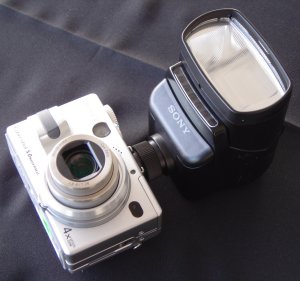
|
|
HVL-F32X Flash on the DSC-V1
|
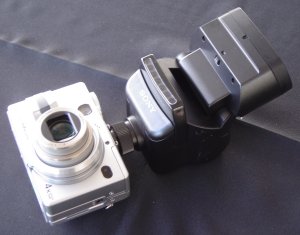
|
|
Bounce Flash
|

|
|
Battery slots (cover removed)
|
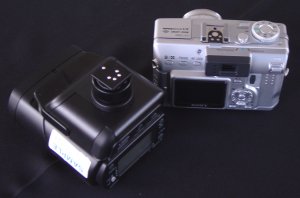
|
|
Hot shoe showing contacts for intelligent flash
|
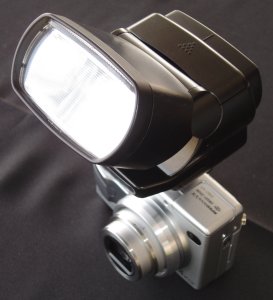
|
|
Modelling flash demonstration
|

|
|
Another angle
|

|
|
Rear view
|

|
|
Display close-up
|

|
|
Manual flash strength
|
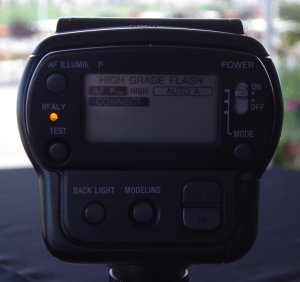
|
|
Another view of the display
|

|
|
Focus illuminator (sorry for the poor image quality)
|

|
|
Sony's hot-air ballooning press event
|